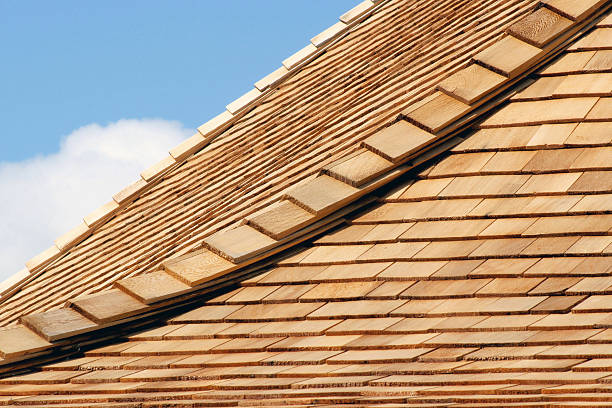Cedar roofs are one of the most aesthetic and durable roofing materials that perfectly complements many different types of buildings, especially residential homes. However, If you have a cedar roof, you should maintain it well to look just as lovely, endearing, and durable as it was when it was first installed. One of the major issues with a cedar roof is warping, which can damage the roof and make it less appealing. But what causes a cedar roof to warp? Read on to find out more.
Overview of a Cedar Roof
A cedar roof is a high-end roofing type constructed from cedar wood. Although it performs the same tasks as a metal or asphalt roof, it is one of the most beautiful roofing materials, distinguishing it from other, more popular types of roofs.
Usually, people hope their roof lasts for a long time after spending huge amounts to install a new one. However, how long your roof lasts depends on how well it is maintained. A cedar roof is no exception to routine quality maintenance. People typically ask what the lifespan of a properly and regularly maintained cedar roof is.
Usually, you can expect to get at least thirty years out of your cedar roof if it is constructed and maintained properly. You can even be up to fifty years out of it if you use high-quality materials and live in a place with no adverse weather conditions. However, your roof might not have such a long lifespan if you reside in a place with adverse weather conditions. Despite its aesthetics and durability, some cedar roofs warp, leaving their owners wondering what might be the cause.
What Causes a Cedar Roof to Warp?
As mentioned earlier, cedar roofs need regular and proper maintenance to maximize their lifespan. Regular and proper maintenance will help prevent weather-related damage and keep your roof looking great. Cedar offers one of the most beautiful and protective roofs possible. However, after around five years, the cedar roof’s natural preservatives might start to deteriorate, leaving the roof vulnerable to harsh weather conditions. The following are the reasons why a cedar roof warps:
1. Sunlight Radiation
The cedar shakes and shingles can be easily damaged by solar radiation. The cedar shakes and shingles turn silvery grey instead of their original golden shade. This alteration in color is a sign that the lignin, the organic adhesive that keeps the wood cells together, is disintegrating.
Tiny gaps in the cedar shakes and shingles develop when the lignin disintegrates, allowing excessive moisture to seep in and cause severe harm. This happens because cedar roofs can sustain damage from UV rays from the sun, just like your skin can. Unfortunately, your roof cannot retract or cover itself from the sun. Ultraviolet rays can also pass through clouds, even when the sun is not visible. Sadly, there is no way to prevent this kind of continuous exposure from robbing cedar shingles of their natural preservatives over time.
2. Moisture
As time passes, your cedar roof will be more vulnerable to absorbing moisture from precipitation and days with high humidity, and it starts to lose some of its natural preservatives. The material may be further exposed to moisture and speed up the process of becoming deformed and rotting in those with roof damage (due to high-speed winds or debris impacting the roof).
The cedar swells when it is wet, then contracts when it dries. This process is called a wet-dry cycle. The sun radiation-induced fissures in the cedar enlarge and deepen over numerous wet-dry cycles. As a result, the shakes and shingles will absorb even more moisture, delaying the speedy drying of the wood. The shakes and shingles consequently start to distort.
3. Moss, mildew, and mold
Moss, mold, mildew, or a combination of all three can start to grow on top of the cedar shakes (as well as underneath if there is some roof damage) due to excessive moisture intrusion. They are indications that there is an issue with excess moisture that has to be fixed. Your cedar roof will distort and rot as long as the growth exists (since it needs moisture to survive).
4. Wood fungi
Although cedar contains natural preservatives, moisture, and sun radiation cause these preservatives to deteriorate over time. Natural wood preservatives are absent, which allows wood-eating fungi (such as white-rot and brown-rot fungi) to infiltrate, colonize, and flourish. This fungus expands quickly and eats away at the wood in the correct conditions.
The shakes and shingles become mushy and spongy when exposed to white-rot fungus, whereas they crack and fall off when exposed to brown-rot fungi. The shingles and shakes will need to be replaced, and you risk an early roof failure if the fungi aren’t removed from the cedar roof in the early stages.
Conclusion
Any issues with your roof will be discovered with routine checks, and it will prevent potential damages from happening. You should clean out any debris from your roof and gutters. The longevity of your cedar shingles will be shortened by wet debris remaining on your cedar roof. Because of this, it’s imperative to do regular roof maintenance to keep your roof in top condition.
It’s challenging to pinpoint exactly when any of these factors can cause damage or when to carry out maintenance. We are experts at Shoreline Roofing and can help you inspect, repair, or replace your roof. You need the services of a roofing professional to help spot damages and carry out regular inspections, and Shoreline Roofing is your best bet.

